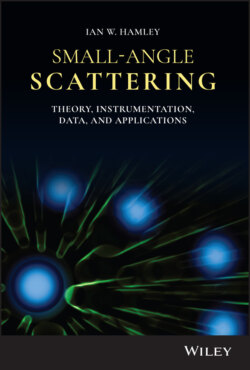Читать книгу Small-Angle Scattering - Ian W. Hamley - Страница 26
1.7.2 Limiting Behaviours
ОглавлениеThe scaling behaviour of the intensity (plotted on a double logarithmic scale) at low q for monodisperse and uniform spheres, long cylinders and flat particles (disc or layer structures) is shown in Figure 1.17, along with examples of calculated form factors (examples of experimental data corresponding to this type of structure are presented in Section 4.13). For spherical particles, the slope is almost zero (it cannot be exactly zero according to the Guinier equation, Eq. (1.24)). For a long cylinder I ∼ q−1 at low q whereas for a flat particle such as a disc or a bilayer structure I ∼ q−2 at low q.
Figure 1.17 Form factors calculated for homogeneous particles along with limiting slopes. Form factors are calculated for spheres of radius R = 30 Å, cylinders of radius R = 30 Å and length L = 1000 Å and discs with thickness T = 30 Å and radius R = 1000 Å. The calculated profiles have been offset vertically for convenience. The minima in principle have zero intensity, but are truncated due to numerical calculation accuracy and for convenience plotting on a logarithmic intensity scale. The profiles were calculated using SASfit [21].
These scaling behaviours for extended rod‐like and flat particles can be derived as discussed in the following section.
Alternatively, the scaling behaviour can be obtained from the behaviours of the autocorrelation functions at large r (relating to low q behaviour of the intensity). For cylinders (radius R), [56]
(1.83)
For flat particles (thickness T) [56]
(1.84)
Substitution of these expressions into Eq. (1.8) leads to the following equations: [56]
(1.85)
(1.86)
For monodisperse spherical particles of radius R, the minima in the form factor are located at qR = 4.493, 7.725... [10]. For an isotropic system of long cylindrical rods (radius R), the form factor minima are located at qR = 3.83, 7.01… [10] and for flat particles (thickness T) at qT/2 = 3.14, 6.28… These values can be obtained from the minima in the corresponding Bessel or sine functions as in the equations in Section 1.7.3.
It should be noted that the form factors and the position of the minima in them depend on products of q and an appropriate particle dimension; therefore, the form factors have the same appearance for different pairs of reciprocal units (i.e. calculations with q in Å−1 with dimensions in Å or q in nm−1 with dimensions in nm give the same result).
